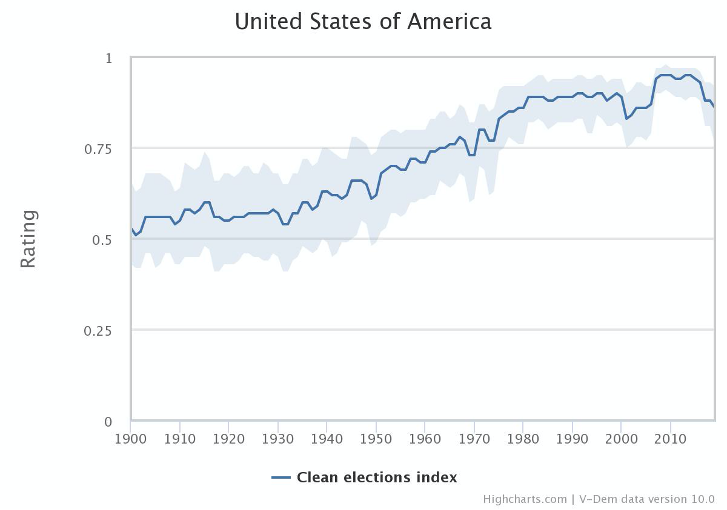Clean Elections in the United States
By: Barbara Yerkes
Jan 20, 2021
Today’s inauguration of Joe Biden as the 46th president of the United States marks the culmination of a tense election, wrought with accusations of voter fraud and irregularities. These claims, although entirely unfounded, bring attention to questions about how experts objectively assess cleanliness of elections. This week’s graph explores the freeness and fairness of elections in the United States from 1900 to 2019 using the Clean Elections Index.
V-Dem classifies clean elections as being free from corruption, irregularities, and partisan intimidation and violence that aims to disrupt the vote. The index also includes data on the effectiveness and independence of election management bodies, the amount of the electorate that registers to vote, and instances of violence or intimidation from foreign actors or parties within the state. It is measured on a scale from zero to one, with higher values representing more free and fair electoral processes.
Generally, the United States shows a positive, upward trend in the Clean Election Index since 1900, reaching a peak of 0.95 in 2015. However, since then, scores for the U.S. show a downward trajectory, dropping to 0.86 by 2019, marking the largest observed decrease for any 4-year period.
Recent downward trends coincide with the adoption of policies that make voting more difficult in specific areas of the country, particularly those with a dense populations of racial minority voters. In 2013 the conservative wing of the Supreme Court, in Shelby County v. Holder (2013), invalidated parts of the Voting Rights Act of 1965, a civil rights era law which sought to curb racial discrimination in elections. The elimination of these protections against discrimination has made it easier for states to pass policies that limit access to the ballot, and this may have contributed to the drop in the index score.
Notably, some states allow or promote policies that indirectly disenfranchise citizens through limitation of the number of voting precincts in densely populated areas[3], enforcement of stringent voter identification laws, the existence of gerrymandered districts, or restricting the voting rights of former felons. These policies disenfranchise voters, discourage voting, or make voting unequally difficult.
While many held that the 2020 election was fortunately absent of fraud and failures in voting infrastructure, the unequal treatment and hardships placed on largely low-income and racial minority citizens through attempted suppression of voting are important factors when considering whether elections are truly free and fair.


